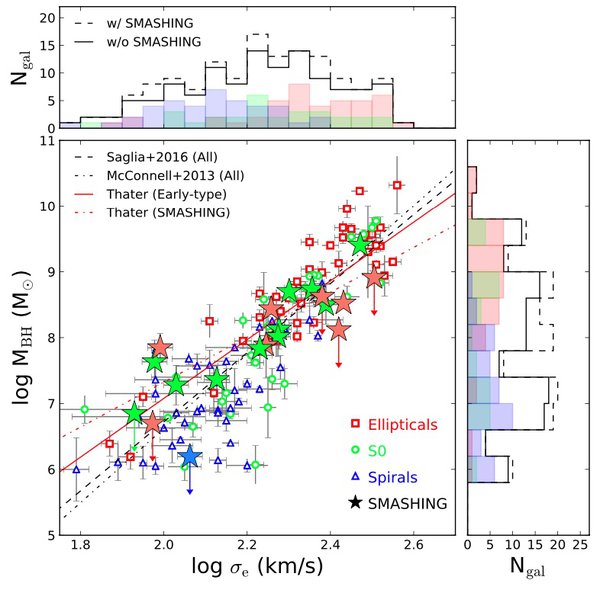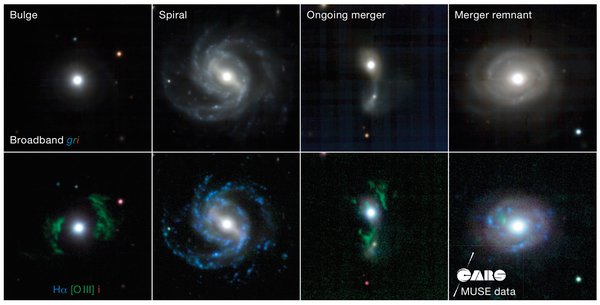Supermassive Black Holes and Active Galactic Nuclei
Kinematic Signatures of Black Holes in Galaxies

A compilation of SMBH masses plotted against the global velocity dispersion relation, including those added recently by our group (large green and red stars). Colours indicate the type of host galaxies, and lines are best fitting relations from various studies (or fitting only some types of galaxies). Credit: Image is taken from the PhD Thesis of Sabine Thater, defended at the University of Potsdam in 2019.
The centres of almost all bright galaxies are hosts to supermassive black holes (SMBH). These extreme objects have have properties similar to the black holes which are created in supernova explosions of massive stars, but with a mass range between million to a few billion solar masses. There are tight correlations between the mass of SMBH and various global properties of galaxies in which they reside, such as their mass, luminosity or a global measure of kinetic energy, their velocity dispersion (see figure on the side). These relations suggest a common evolution, or better to say, an interlinked growth of SMBH and host galaxies.
In order to understand this relationship, we are pursuing observational projects which aim at measuring the masses of supermassive black holes in different galaxies, trying to cover the exiting relations, as well as extending them to yet uncharted regions. Our goal is to determine SMBH masses in the most massive galaxies, residing in centres of galaxy clusters, with complex shapes and stellar orbits, but also dynamically simpler and less massive galaxies of axisymmetric shapes. And we aim to extend the relations to low-mass galaxies and even globular clusters, which should host the intermediate mass black holes with masses of "only" several thousand solar masses. Our group has already published a few dozen SMBH masses by applying advanced dynamical models to state of the art observations of nearby galaxies, with ground-based laser guide star adaptive optics facilities (e.g. SINFONI or MUSE at VLT, NIFS at GEMINI North), as well as the Hubble Space Telescope (and in future the James Webb Telescope).
The Close AGN Reference Survey
The Close AGN Reference Survey (CARS) is an international collaboration project and aims at providing the most detailed view on the AGN-host galaxy connection based on a sample of nearby, unobscured AGN (0.01 < z < 0.06). Our goal is to establish a unique reference data set for AGN host galaxies at low redshift as an anchor point for comparison with high-redshift AGN. For CARS we systematically combine spatially-resolved observations across the entire electromagnetic spectrum, from X-ray to radio, for a representative sample of local AGN. This is only possible by combining many different observatories using state-of-the-art instrumentation.
Recent highlights include:
- The discovery of a changing-look AGN Mrk1018 in our CARS data (McElroy et al. 2016, Husemann et al. 2016, Krumpe et al. 2017)
- Discovery of a large scale outflow on the edge-on galaxy HE1353-1917 and assessing its impact on the host galaxy (Husemann et al. 2019)
- The first detection of spatially resolved [CII] with SOFIA at large distances (Busch et al. 2018)
- A comparative analysis of star-formation in barred galaxies (Neumann et al. 2019).
